He Knew What Was Coming: Behind Trump’s Failure on the Virus
He Could Have Seen What Was Coming:
Behind Trump’s Failure on the Virus
“You guys made fun of me screaming to close the schools,” he wrote to the group, which called itself “Red Dawn,” an inside joke based on the 1984 movie about a band of Americans trying to save the country after a foreign invasion. “Now I’m screaming, close the colleges and universities.”
He was hardly a lone voice. Throughout January, as Mr. Trump repeatedly played down the seriousness of the virus and focused on other issues, an array of figures inside his government — from top White House advisers to experts deep in the cabinet departments and intelligence agencies — identified the threat, sounded alarms and made clear the need for aggressive action.
The president, though, was slow to absorb the scale of the risk and to act accordingly, focusing instead on controlling the message, protecting gains in the economy and batting away warnings from senior officials.
Even after Mr. Trump took his first concrete action at the end of January — limiting travel from China — public health often had to compete with economic and political considerations in internal debates, slowing the path toward belated decisions to seek more money from Congress, obtain necessary supplies, address shortfalls in testing and ultimately move to keep much of the nation at home.
Unfolding as it did in the wake of his impeachment by the House and in the midst of his Senate trial, Mr. Trump’s response was colored by his suspicion of and disdain for what he viewed as the “Deep State” — the very people in his government whose expertise and long experience might have guided him more quickly toward steps that would slow the virus, and likely save lives.
Decision-making was also complicated by a long-running dispute inside the administration over how to deal with China. The virus at first took a back seat to a desire not to upset Beijing during trade talks, but later the impulse to score points against Beijing left the world’s two leading powers further divided as they confronted one of the first truly global threats of the 21st century.
The shortcomings of Mr. Trump’s performance have played out with remarkable transparency as part of his daily effort to dominate television screens and the national conversation.
But dozens of interviews with current and former officials and a review of emails and other records revealed many previously unreported details and a fuller picture of the roots and extent of his halting response as the deadly virus spread:
■ The National Security Council office responsible for tracking pandemics received intelligence reports in early January predicting the spread of the virus to the United States, and within weeks was raising options like keeping Americans home from work and shutting down cities the size of Chicago. Mr. Trump would avoid such steps until March.
■ Despite Mr. Trump’s denial weeks later, he was told at the time about a Jan. 29 memo produced by his trade adviser, Peter Navarro, laying out in striking detail the potential risks of a coronavirus pandemic: as many as half a millions deaths and trillions of dollars in economic losses.
■ The health and human services secretary, Alex M. Azar II, directly warned Mr. Trump of the possibility of a pandemic during a call on Jan. 30, the second warning he delivered to the president about the virus in two weeks. The president, who was on Air Force One while traveling for appearances in the Midwest, responded that Mr. Azar was being alarmist.
■ Mr. Azar publicly announced in February that the government was establishing a “surveillance” system in five American cities to measure the spread of the virus and enable experts to project the next hot spots. It was delayed for weeks. The slow start of that plan, on top of the well-documented failures to develop the nation’s testing capacity, left administration officials with almost no insight into how rapidly the virus was spreading. “We were flying the plane with no instruments,” one official said.
■ By the third week in February, the administration’s top public health experts concluded they should recommend to Mr. Trump a new approach that would include warning the American people of the risks and urging steps like social distancing and staying home from work. But the White House focused instead on messaging and crucial additional weeks went by before their views were reluctantly accepted by the president — time when the virus spread largely unimpeded.
When Mr. Trump finally agreed in mid-March to recommend social distancing across the country, effectively bringing much of the economy to a halt, he seemed shellshocked and deflated to some of his closest associates. One described him as “subdued” and “baffled” by how the crisis had played out. An economy that he had wagered his re-election on was suddenly in shambles.
He only regained his swagger, the associate said, from conducting his daily White House briefings, at which he often seeks to rewrite the history of the past several months. He declared at one point that he “felt it was a pandemic long before it was called a pandemic,” and insisted at another that he had to be a “cheerleader for the country,” as if that explained why he failed to prepare the public for what was coming.
Mr. Trump’s allies and some administration officials say the criticism has been unfair. The Chinese government misled other governments, they say. And they insist that the president was either not getting proper information, or the people around him weren’t conveying the urgency of the threat. In some cases, they argue, the specific officials he was hearing from had been discredited in his eyes, but once the right information got to him through other channels, he made the right calls.
“While the media and Democrats refused to seriously acknowledge this virus in January and February, President Trump took bold action to protect Americans and unleash the full power of the federal government to curb the spread of the virus, expand testing capacities and expedite vaccine development even when we had no true idea the level of transmission or asymptomatic spread,” said Judd Deere, a White House spokesman.
There were key turning points along the way, opportunities for Mr. Trump to get ahead of the virus rather than just chase it. There were internal debates that presented him with stark choices and moments when he could have chosen to ask deeper questions and learn more. How he handled them may shape his re-election campaign. They will certainly shape his legacy.
The Containment Illusion
By the last week of February, it was clear to the administration’s public health team that schools and businesses in hot spots would have to close. But in the turbulence of the Trump White House, it took three more weeks to persuade the president that failure to act quickly to control the spread of the virus would have dire consequences.
When Dr. Robert Kadlec, the top disaster response official at the Health and Human Services Department, convened the White House coronavirus task force on Feb. 21, his agenda was urgent. There were deep cracks in the administration’s strategy for keeping the virus out of the United States. They were going to have to lock down the country to prevent it from spreading. The question was: When?
There had already been an alarming spike in new cases around the world and the virus was spreading across the Middle East. It was becoming apparent that the administration had botched the rollout of testing to track the virus at home, and a smaller-scale surveillance program intended to piggyback on a federal flu tracking system had also been stillborn.
In Washington, the president was not worried, predicting that by April, “when it gets a little warmer, it miraculously goes away.” His White House had yet to ask Congress for additional funding to prepare for the potential cost of wide-scale infection across the country, and health care providers were growing increasingly nervous about the availability of masks, ventilators and other equipment.
What Mr. Trump decided to do next could dramatically shape the course of the pandemic — and how many people would get sick and die.
With that in mind, the task force had gathered for a tabletop exercise — a real-time version of full-scale wargaming of a flu pandemic the administration had run the previous year. That earlier exercise, also conducted by Mr. Kadlec and called “Crimson Contagion,” predicted 110 million infections, 7.7 million hospitalizations and 586,000 deaths following a hypothetical outbreak that started in China.
Facing the likelihood of a real pandemic, the group needed to decide when to abandon “containment” — the effort to keep the virus outside the U.S. and to isolate anyone who gets infected — and embrace “mitigation” to thwart the spread of the virus inside the country until a vaccine becomes available.
Among the questions on the agenda, which was reviewed by The New York Times, was when the department’s secretary, Mr. Azar, should recommend that Mr. Trump take textbook mitigation measures “such as school dismissals and cancellations of mass gatherings,” which had been identified as the next appropriate step in a Bush-era pandemic plan.
The exercise was sobering. The group — including Dr. Anthony S. Fauci of the National Institutes of Health; Dr. Robert R. Redfield of the Centers for Disease Control and Prevention, and Mr. Azar, who at that stage was leading the White House Task Force — concluded they would soon need to move toward aggressive social distancing, even at the risk of severe disruption to the nation’s economy and the daily lives of millions of Americans.
If Dr. Kadlec had any doubts, they were erased two days later, when he stumbled upon an email from a researcher at the Georgia Institute of Technology, who was among the group of academics, government physicians and infectious diseases doctors who had spent weeks tracking the outbreak in the Red Dawn email chain.
A 20-year-old Chinese woman had infected five relatives with the virus even though she never displayed any symptoms herself. The implication was grave — apparently, healthy people could be unknowingly spreading the virus — and supported the need to move quickly to mitigation.
“Is this true?!” Dr. Kadlec wrote back to the researcher. “If so we have a huge whole on our screening and quarantine effort,” including a typo where he meant hole. Her response was blunt: “People are carrying the virus everywhere.”
The following day, Dr. Kadlec and the others decided to present Mr. Trump with a plan titled “Four Steps to Mitigation,” telling the president that they needed to begin preparing Americans for a step rarely taken in United States history.
But over the next several days, a presidential blowup and internal turf fights would sidetrack such a move. The focus would shift to messaging and confident predictions of success rather than publicly calling for a shift to mitigation.
These final days of February, perhaps more than any other moment during his tenure in the White House, illustrated Mr. Trump’s inability or unwillingness to absorb warnings coming at him. He instead reverted to his traditional political playbook in the midst of a public health calamity, squandering vital time as the coronavirus spread silently across the country.
Dr. Kadlec’s group wanted to meet with the president right away, but Mr. Trump was on a trip to India, so they agreed to make the case to him in person as soon as he returned two days later. If they could convince him of the need to shift strategy, they could immediately begin a national education campaign aimed at preparing the public for the new reality.
A memo dated Feb. 14, prepared in coordination with the National Security Council and titled “U.S. Government Response to the 2019 Novel Coronavirus,” documented what more drastic measures would look like, including: “significantly limiting public gatherings and cancellation of almost all sporting events, performances, and public and private meetings that cannot be convened by phone. Consider school closures. Widespread ‘stay at home’ directives from public and private organizations with nearly 100% telework for some.”
The memo did not advocate an immediate national shutdown but said the targeted use of “quarantine and isolation measures” could be used to slow the spread in places where “sustained human-to-human transmission” is evident.
Within 24 hours, before they got a chance to make their presentation to the president, the plan went awry.
Mr. Trump was walking up the steps of Air Force One to head home from India on Feb. 25 when Dr. Nancy Messonnier, the director of the National Center for Immunization and Respiratory Diseases, publicly issued the blunt warning they had all agreed was necessary.
But Dr. Messonnier had jumped the gun. They had not told the president yet, much less gotten his consent.
The number of infections in the United States started to surge through February and early March, but the Trump administration did not move to place large-scale orders for masks and other protective equipment, or critical hospital equipment, such as ventilators. The Pentagon sat on standby, awaiting any orders to help provide temporary hospitals or other assistance.
As February gave way to March, the president continued to be surrounded by divided factions even as it became clearer that avoiding more aggressive steps was not tenable.
Mr. Trump had agreed to give an Oval Office address on the evening of March 11 announcing restrictions on travel from Europe, where the virus was ravaging Italy. But responding to the views of his business friends and others, he continued to resist calls for social distancing, school closures and other steps that would imperil the economy.
But the virus was already multiplying across the country — and hospitals were at risk of buckling under the looming wave of severely ill people, lacking masks and other protective equipment, ventilators, and sufficient intensive care beds. The question loomed over the president and his aides after weeks of stalling and inaction: What were they going to do?
The approach that Mr. Azar and others had planned to bring to him weeks earlier moved to the top of the agenda. Even then, and even by Trump White House standards, the debate over whether to shut down much of the country to slow the spread was especially fierce.
Always attuned to anything that could trigger a stock market decline or an economic slowdown that could hamper his re-election effort, Mr. Trump also reached out to prominent investors like Stephen A. Schwarzman, the chief executive of Blackstone Group, a private equity firm.
“Everybody questioned it for a while, not everybody, but a good portion questioned it,” Mr. Trump said earlier this month. “They said, let’s keep it open. Let’s ride it.”
In a tense Oval Office meeting, when Mr. Mnuchin again stressed that the economy would be ravaged, Mr. O’Brien, the national security adviser, who had been worried about the virus for weeks, sounded exasperated as he told Mr. Mnuchin that the economy would be destroyed regardless if officials did nothing.
Soon after the Oval Office address, Dr. Scott Gottlieb, the former commissioner of the Food and Drug Administration and a trusted sounding board inside the White House, visited Mr. Trump, partly at the urging of Jared Kushner, the president’s son-in-law. Dr. Gottlieb’s role was to impress upon the president how serious the crisis could become.
But in the end, aides said, it was Dr. Deborah L. Birx, the veteran AIDS researcher who had joined the task force, who helped to persuade Mr. Trump. Soft-spoken and fond of the kind of charts and graphs Mr. Trump prefers, Dr. Birx did not have the rough edges that could irritate the president. He often told people he thought she was elegant.
On Monday, March 16, Mr. Trump announced new social distancing guidelines, saying they would be in place for two weeks. The subsequent economic disruptions were so severe that the president repeatedly suggested that he wanted to lift even those temporary restrictions. He frequently asked aides why his administration was still being blamed in news coverage for the widespread failures involving testing, insisting the responsibility had shifted to the states.
During the last week in March, Kellyanne Conway, a senior White House adviser involved in task force meetings, gave voice to concerns other aides had. She warned Mr. Trump that his wished-for date of Easter to reopen the country likely couldn’t be accomplished. Among other things, she told him, he would end up being blamed by critics for every subsequent death caused by the virus.
Within days, he watched images on television of a calamitous situation at Elmhurst Hospital Center, miles from his childhood home in Queens, N.Y., where 13 people had died from the coronavirus in 24 hours.
He left the restrictions in place.
Read the entire article here: The New York Times
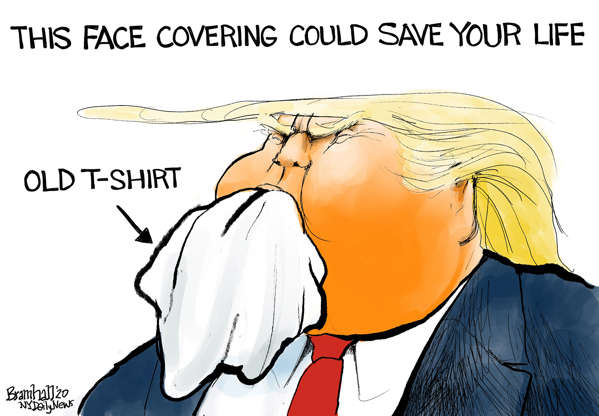
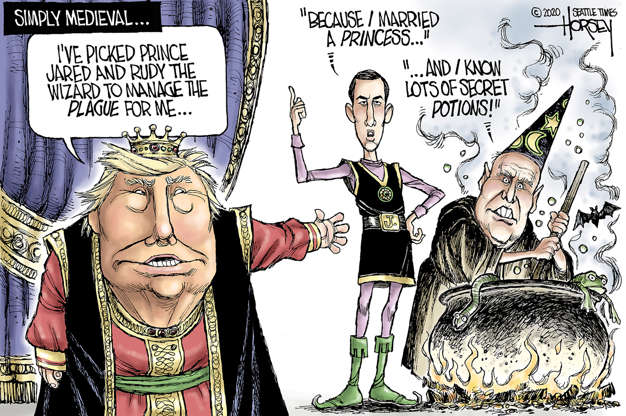
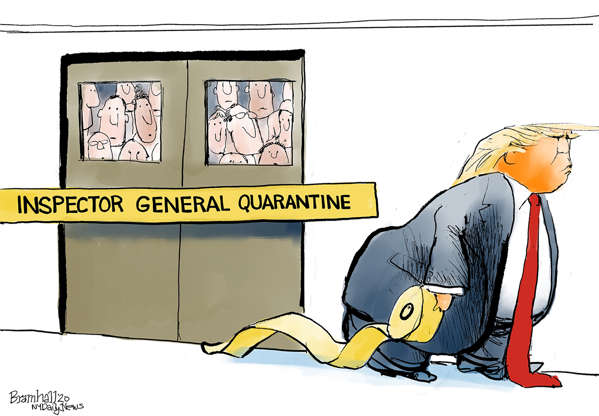
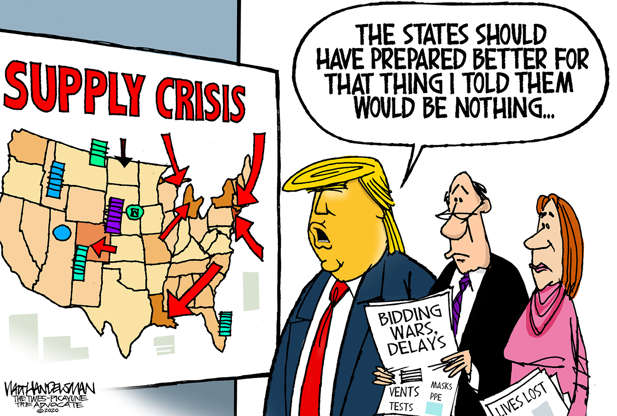
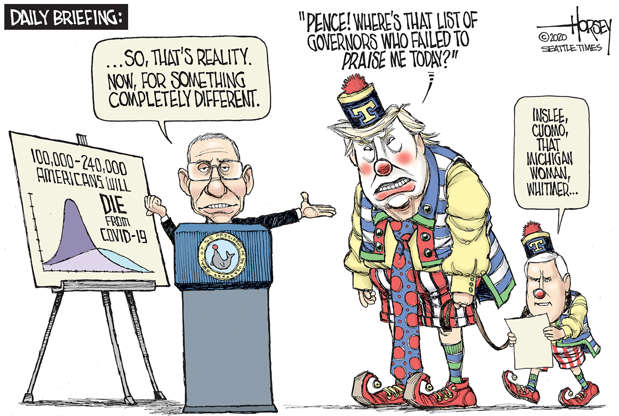
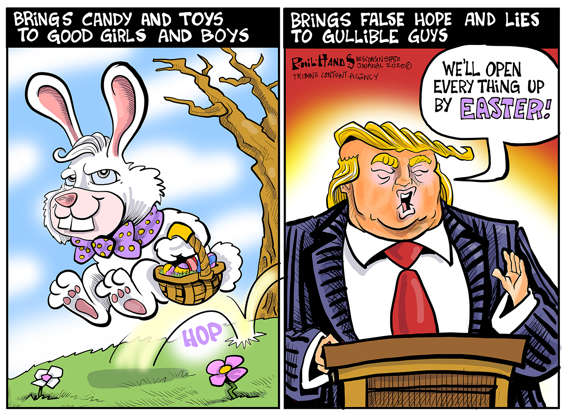


Comments
Post a Comment